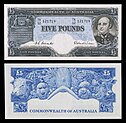
Back Australisches Pfund German Libra australiana Spanish پوند استرالیا Persian Australian punta Finnish Livre australienne French Ավստրալիական ֆունտ Armenian Pound Australia ID Sterlina australiana Italian オーストラリア・ポンド Japanese 오스트레일리아 파운드 Korean
| |||||
| Unit | |||||
|---|---|---|---|---|---|
| Unit | pound | ||||
| Plural | pounds | ||||
| Symbol | £ | ||||
| Denominations | |||||
| Subunit | |||||
| 1⁄20 | shilling | ||||
| 1⁄240 | penny | ||||
| Plural | |||||
| penny | pence | ||||
| Symbol | |||||
| shilling | s, /– | ||||
| penny | d | ||||
| Banknotes | |||||
| Freq. used | 10/–, £1, £5, £10 | ||||
| Rarely used | £20, £50, £100, £1,000 | ||||
| Coins | 1⁄2d, 1d, 3d, 6d, 1/-, 2/-, 5/- (5/- only used from 1937 to 1938) | ||||
| Demographics | |||||
| Date of introduction | 1910 | ||||
| Date of withdrawal | 14 February 1966 | ||||
| Replaced by | Australian dollar | ||||
| User(s) | Australia | ||||
| Issuance | |||||
| Central bank |
| ||||
| Valuation | |||||
| Pegged with | initially to sterling at par, then at £A 1 = 16 shillings sterling | ||||
| Pegged by | New Guinea pound at par | ||||
| This infobox shows the latest status before this currency was rendered obsolete. | |||||
The pound (sign: £, £A[1] for distinction) was the currency of Australia from 1910 until 14 February 1966, when it was replaced by the Australian dollar. Like other £sd currencies, it was subdivided into 20 shillings (denoted by the symbol s or /–), each of 12 pence (denoted by the symbol d).
- ^ "CBCS Pocket Compendium of Australian Statistics, No. 30 - 1944". December 1944.

